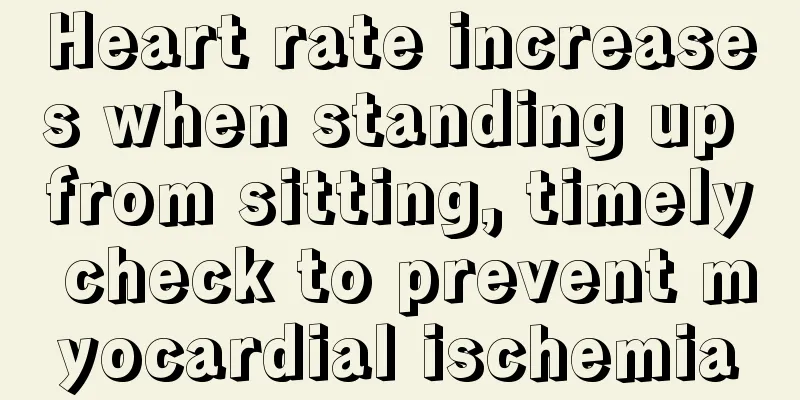Heart rate increases when standing up from sitting, timely check to prevent myocardial ischemia

|
When our heart rate increases when we stand up from sitting, the most common possibility is myocardial ischemia. The incidence of myocardial ischemia is high among middle-aged and elderly people. Especially now that our living standards are high, myocardial ischemia is more likely to occur. If related symptoms occur, you should seek medical attention in time. 1. Symptoms of myocardial ischemia (1) When tired or mentally stressed, dull pain or tightening pain may occur behind the sternum or in front of the heart, radiating to the left shoulder and left upper arm, lasting for 3-5 minutes, and relieved on its own after rest, sometimes accompanied by profuse sweating. (2) Those who experience chest tightness, palpitations, and shortness of breath during physical activity and whose symptoms are relieved by rest. (3) Exercise-related sore throat, burning sensation, tightness, toothache, etc. (4) People who experience chest pain or tightness after a full meal, exposure to cold or drinking alcohol. (5) People who feel chest tightness and shortness of breath when sleeping with a low pillow at night and need to lie with a high pillow to feel comfortable; people who suddenly experience chest pain, palpitations, or difficulty breathing when sleeping soundly or lying flat during the day and need to sit up or stand up immediately to feel relieved. (6) Palpitations, chest tightness, shortness of breath, or chest pain during sexual intercourse or straining to defecate. (7) Sudden bradycardia, hypotension or syncope. 2. Inspection 1. Examination of risk factors related to coronary heart disease. In order to detect myocardial ischemia as early as possible, people over 40 years old should undergo regular physical examinations to understand whether they have risk factors related to coronary heart disease, such as blood lipids, blood pressure, blood sugar, neck vascular ultrasound, cardiac ultrasound, electrocardiogram and other examinations. 2. Check under load test. If you are at high risk of myocardial ischemia, you should ask your doctor whether you have typical symptoms of coronary heart disease and decide whether you need to undergo stress tests, such as treadmill electrocardiogram, adenosine stress echocardiogram, and multi-slice coronary CT. 3. Coronary angiography. Through non-invasive evaluation, it is determined whether further diagnosis using coronary angiography, the gold standard for diagnosing coronary heart disease, is needed to clarify the extent and range of coronary artery lesions. |
<<: What is the appropriate SPF?
>>: Anal bleeding, what's going on?
Recommend
Exercise methods for kidney cancer patients
What kind of exercise is suitable for kidney canc...
What shampoo to use for hard hair
Hair is a very important part of our body. The qu...
What are the interventional treatments for advanced liver cancer? Four interventional treatments for advanced liver cancer
The currently recognized radical treatment method...
What is the diagnostic order of fibroids?
The difficulty in curing fibroids is a major char...
What is spinal herniation?
As the name suggests, spinal herniation means tha...
How does skin cancer spread
Not everyone can have a healthy life, there is al...
How to treat pneumococcal pneumonia
Pneumonia is a common and frequently occurring di...
What are the causes of vertigo syndrome
Many people have had this experience in life. The...
Successfully removed the ink from the skin
Ink is something that many people come into conta...
There are red bumps on the buttocks
The buttocks is a relatively hidden part of our b...
What are the symptoms of waist wind?
The waist is an important part of our body. If th...
Can MRI diagnosis of prostate cancer lead to misdiagnosis?
A new method for diagnosing prostate cancer is be...
Can stomach cancer be cured
Can stomach cancer be cured? Gastric cancer is a ...
What foods can you eat to prevent lung cancer? Seven kinds of food are suitable for lung cancer patients
With the increase in the number of smokers and th...
What are the signs of bladder cancer recurrence
Bladder cancer is not only a common malignant tum...









